Russia / Российская Федерация – Let’s explore here
What’s it like in Russia?
Russia is a transcontinental country – it is located both in Europe and in Asia. Because of this, the information is located both in our European and in our Asian travel destination sections. Don’t worry though, all the information for this amazing country is captured on this page.
Russia is the largest country in the world, with a very long and turbulent history. It’s so large that it has eleven time zones, and covers one eighth of inhabited land on earth! Russia has the most land borders of any country, and includes Azerbaijan, Belarus, China, Estonia, Finland, Georgia, Kazakhstan, Latvia, Lithuania, Mongolia, North Korea, Norway, Poland and Ukraine.
Lake Baikal in the east of Russia, is the world’s oldest and deepest fresh water lake in the world. With over 100,000 rivers, Russia holds one quarter of the world’s fresh water. About half of Russia’s territory is forested, and there are many mountain ranges, mainly along the southern border and in north east Siberia. The highest point is Mount Elbrus in the Caucasus Mountains, close to Georgia, at 18,510 ft (5,642m) above sea level.
The population of Russia is around 145 million people, about one in seven of whom live in the metropolitan area of the capital, Moscow.
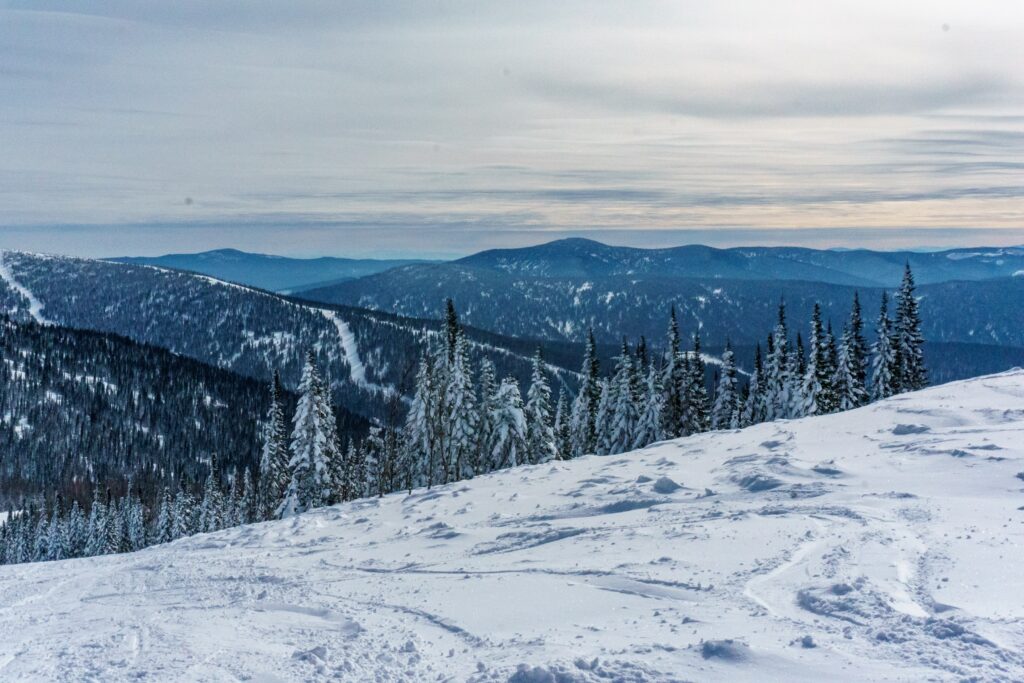
A bit about the history of Russia
Early History and Kievan Rus
The history of Russia begins with the early Slavic tribes that inhabited the region. The formation of Kievan Rus in the 9th century marks the first significant state in the history of Russia. Founded by Scandinavian Vikings, particularly the Varangians, Kievan Rus became a powerful federation of Slavic tribes. It flourished under rulers like Prince Vladimir the Great, who adopted Christianity for the state in 988, leading to the Christianisation of the region. By the 12th century, however, Kievan Rus fractured into smaller principalities, weakening its power.
Mongol Invasion and the Rise of Moscow
In the 13th century, the Mongol Empire invaded the territories of Kievan Rus, and the region was placed under Mongol rule. This period, known as the ‘Tatar Yoke’, lasted until the late 15th century. During this time, the Grand Duchy of Moscow rose in prominence. Moscow’s rulers, such as Ivan III (Ivan the Great), gradually united the Russian lands and threw off Mongol control in 1480, marking the beginning of a strong centralised Russian state.
The Tsardom of Russia
In 1547, Ivan IV, also known as Ivan the Terrible, declared himself the first Tsar of Russia, establishing the Tsardom of Russia. Ivan’s reign was marked by territorial expansion, the centralization of power, and the establishment of autocratic rule. The tsardom continued to expand its territory under subsequent rulers, including the Romanovs, who came to power in 1613 following the Time of Troubles, a period of political instability.
The Russian Empire
In 1721, under Tsar Peter I (Peter the Great), Russia became an empire. Peter implemented significant reforms, modernising Russia’s military, economy and government to align more closely with Western European powers. His establishment of St. Petersburg as the new capital symbolised his desire to bring Russia closer to Europe. The Russian Empire expanded considerably during the 18th and 19th centuries, becoming one of the largest empires in history, covering much of eastern Europe, central Asia, and parts of North America.
The Fall of the Russian Empire
In the early 20th century, it faced significant social, political and economic turmoil. Tsar Nicholas II, the last monarch of Russia, faced growing discontent due to the harsh conditions for peasants, workers and soldiers. The Russian Revolution of 1917, triggered by widespread disillusionment and the hardships of World War I, led to the abdication of Nicholas II and the end of the Romanov dynasty. The February Revolution and the subsequent October Revolution led by the Bolsheviks, under Vladimir Lenin, saw the rise of the Soviet government.
The Soviet Union
The Bolshevik Revolution resulted in the establishment of the Soviet Union in 1922, a socialist state that spanned much of the former Russian Empire. Lenin led the country until his death in 1924, after which Joseph Stalin took control. Under Stalin, the Soviet Union became a major world power, but his rule was marked by intense political repression, forced collectivisation, purges and widespread famine. After World War II, the Soviet Union emerged as one of the two superpowers, competing with the United States during the Cold War. The Soviet Union expanded its influence across eastern Europe and beyond, becoming a major player in global politics.
Decline and the Fall of the Soviet Union
In the 1980s, economic stagnation, political corruption, and the rigid structure of the Communist Party led to widespread discontent. Mikhail Gorbachev, the last leader of the Soviet Union, attempted reforms with policies like glasnost (openness) and perestroika (restructuring), but these measures failed to address the underlying problems. In 1991, after a failed coup and growing independence movements within its republics, the Soviet Union dissolved, and Russia became an independent country under President Boris Yeltsin.
Post-Soviet Russia
After the collapse of the Soviet Union, Russia faced significant challenges, including economic hardship, political instability, and a decline in global influence. The 1990s saw a difficult transition from a planned economy to a market based one, marked by high inflation, poverty, and widespread corruption. Vladimir Putin, who became president in 2000, played a major role in stabilising the country, restoring economic growth, and increasing Russia’s global influence. Putin’s leadership has been characterised by increasing centralisation of power, political control, and a more assertive foreign policy.
Modern Russia
Today, it is a major global power with significant influence in international politics, although it faces ongoing challenges, including political opposition, economic sanctions and demographic decline. It’s political system remains under the control of the executive branch, with Putin holding significant power. The country has been involved in various international conflicts, including the annexation of Crimea in 2014 and military interventions in Syria and Ukraine. Despite economic sanctions, Russia remains a major player on the world stage with significant military capabilities and a growing economy.

Russia road trip
We’ve been to Russia before, although as it’s such a massive country, we’ve only seen a tiny part of it, and all based in the European part of the country. As part of our Asian road trip, the journey would involve driving through Russia. Similarly our visit to the Stans may involve driving through Russia, due to the land border issue in Azerbaijan (see our blog).
Additionally, due to the political uncertainty and conflict in the area, we do not currently have an itinerary for a road trip through Russia. When we do though, hopefully it will improve our knowledge of this intriguing and beautiful country, and enable us to meet some interesting people. We’ll be updating this page at that time – don’t forget to check back 🙂
Map of Russia

Our favourite places in Russia
These are some of the best places that we explored on our road trip through Russia. We’ve put them in alphabetical order.
Moscow, Russia
Life in Moscow under the USSR
I was fortunate enough to visit Russia when it was still the Union of Soviet Socialist Republics. This was during the Cold War, before the Berlin Wall fell, and whilst the Iron Curtain was still in force. I can honestly say that the vast majority of the Russians that I met there were some of the most friendly, welcoming and helpful people that I’ve ever met!
I recall being taken to some really great cafés with some lovely ice cream sodas and amazing tea ceremonies. We weren’t chaperoned anywhere – so we explored where we wanted, within the city. We were also taken on a ferris wheel in the centre of Moscow by some really friendly students from the university – it was lovely weather when we got on, but freezing at the top! In retrospect I look at the rust on the wheel (see below) with bemusement!
Ration cards in the USSR
Back when I visited, ration cards were still the norm. if you wanted to buy provisions, you’d queue up to look at what there was to buy, then you’d queue up to pay for it, and then you queue up again to collect it – super efficient! That said, there were no beggars or unemployed, and everyone had access to food and shelter 🤔
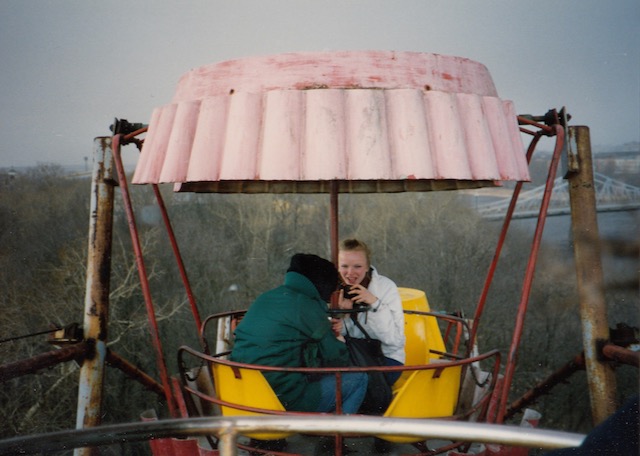
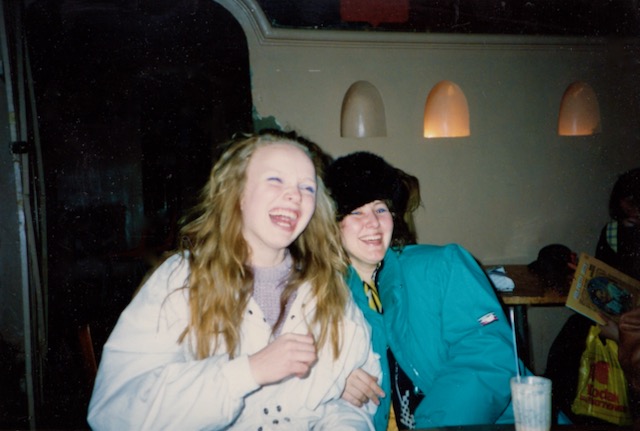
At the time if you wanted to travel outside of the city you’d need to obtain a permit. We were told that this was the case no matter whether you were a citizen or otherwise. We got very lost, late one night – it was quite scary at that time! However a group of random Russians saw our plight, chipped in together to give us some of their rationed travel tickets, whilst one of the women put us on a bus and travelled with us to take us back to where we were staying! It was over an hours journey she went out of way to make – we were so grateful 🙏
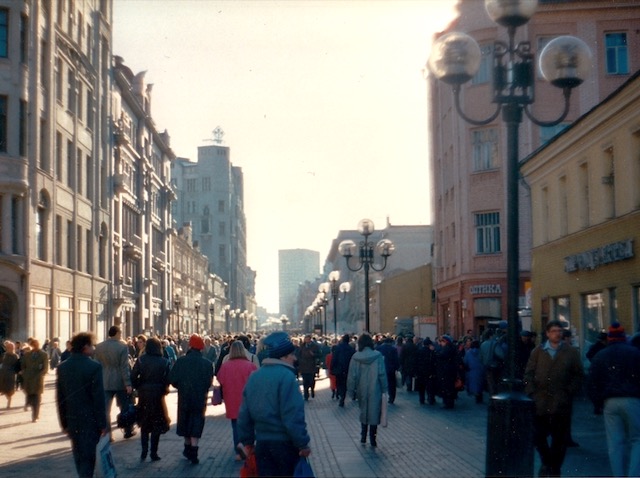

Moscow State University
We visited Moscow University and the students there were super friendly and immensely curious. I guess that this is no surprise really, as there was an information blackout between their country and the western world.
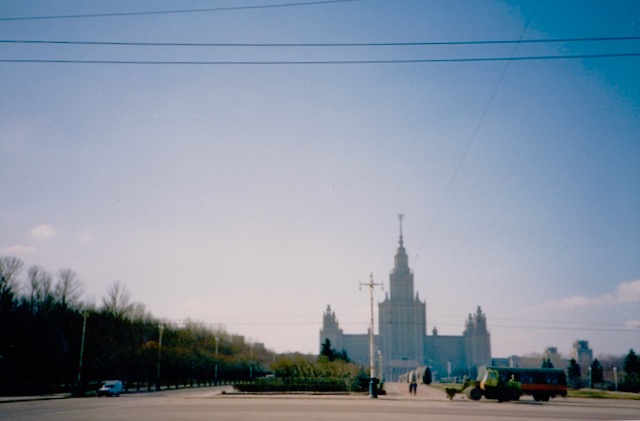
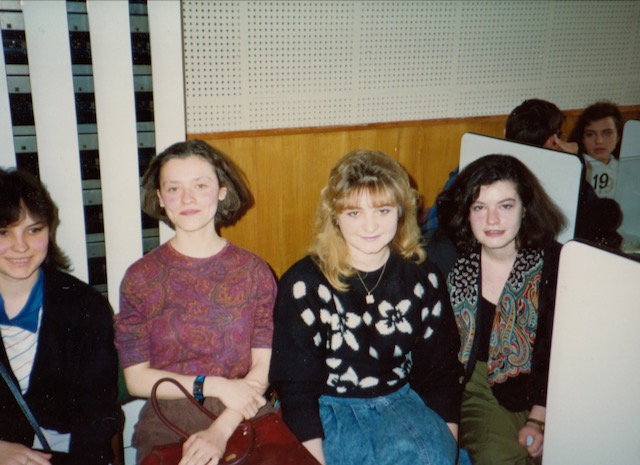
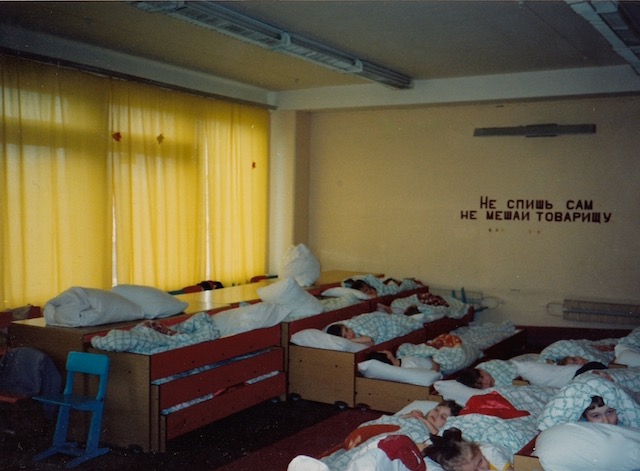
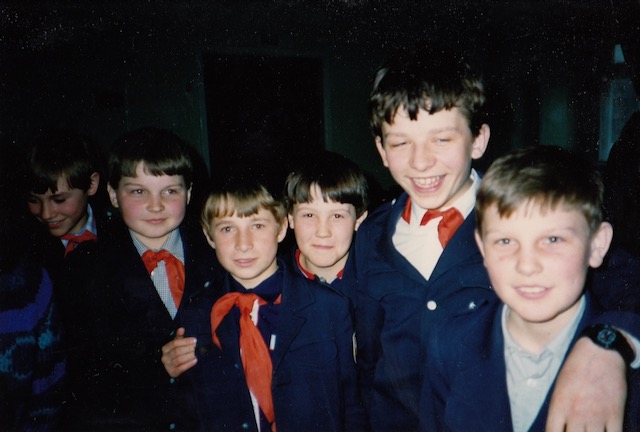
What’s it like to drive in Russia?
They drive on the right hand side of the road in Russia, and it is, of course, massive! In my experience, you can drive for very lengthy periods of time through forests of silver birches without seeing anyone else. There are only around 150 million people in the whole country, making it one of the least densely populated on earth. It’s also very (or extremely) cold in large parts, for much of the year. So lots of snow, cold slushy mud, and some difficult terrain to traverse. It is essential to check out conditions and properly plan should you wish to travel there.
Do you require an international driving permit in Russia?
We’ve created a dedicated page to driving abroad, which answers this question, and more, which you might find helpful.
Can you use your UK driving license when driving through Russia?
We’ve created a dedicated page to driving abroad, which answers this question, and more, which you might find helpful.
Do I need a carnet de passages to drive in Russia?
We’ve created a dedicated page to driving abroad, which answers this question, and more, which you might find helpful.
Do you require an international driving permit in Russia?
We’ve created a dedicated page to driving abroad, which answers this question, and more, which you might find helpful.
Can you use your UK driving license when driving through Russia?
We’ve created a dedicated page to driving abroad, which answers this question, and more, which you might find helpful.
Do I need a carnet de passages to drive in Russia?
We’ve created a dedicated page to driving abroad, which answers this question, and more, which you might find helpful.
What are the speed limits in Russia?
The speed limits for cars in Russia are:
- 15 mph (20 km/h) for urban driving
- 45 mph (60 km/h) outside of built up areas
- 55 mph (90 km/h) on dual carriageways
- 70 mph (110 km/h) on motorways
Driving in the USSR
So back when I visited Russia, most of Eastern Europe was part of the USSR, so driving conditions varied so widely we’d need an entire website just dedicated to it! Also, back then, in order to obtain a car, you had to put your name on a list and wait. If you were deemed as someone it was necessary should have one, you’d get one quickly. Otherwise the wait could sometime become years! Most cars in Moscow at the time were USSR made, so Ladas mostly.
What currency do they use in Russia?
In Russia they use the Rouble. The use of credit / debit cards issued outside of Russia is now prohibited. Travellers cheques are not currently accepted. There are lots of ATMs, although they won’t accept cards issued outside of Russia. It is currently difficult to obtain Roubles from within the UK, you should take US dollars or euros to exchange.
You should make yourself aware of the amount that your bank charges you for using credit and debit cards abroad. Often credit cards are cheaper for purchasing items directly, and for withdrawing cash from ATMs.
What language do they speak in Russia?
They speak Russian in Russia, however due to the size of the country, there are another 35 languages which are used as official languages in different regions of Russia. The country is also home to about 100 other minority languages! English and German are also spoken, but mostly in major cities and in international business areas.
What time zone is Russia in?
Russia is so massive, it crosses eleven time zones! So it very much depends where you are in Russia in order to determine which time zone you are in.
Remember, when you’re planning your next trip to take a look at what time zone it’s in.
Do I need a visa to visit Russia?
We’ve created a dedicated, more comprehensive page on visas, which you should find helpful. Check it out!
Is wild camping legal in Russia?
Yes, wild camping is fine in Russia, although you should avoid national parks and natural reserves.
What plug / socket type do they use in Russia?
In Russia they use plug / socket types C and F.


Health issues in Russia
Is it safe to drink water in Russia?
No, it is not safe to drink tap water in Russia. Bottled water is readily available across the country.
What vaccinations are required for Russia?
This NHS website is kept up to date with all relevant information on vaccinations in Russia.
Phones in Russia
What is the country calling code for Russia?
The country calling code for Russia is +7
What are the emergency phone numbers in Russia?
- The emergency number for police in Russia is: 112 / 102
- In Russia, the emergency number for ambulance is: 112 / 103
- The emergency number for fire in Russia is: 112 / 101
If you’ve got some useful info that you’d like to share, let us know!
And don’t forget to check out all the other pictures!
